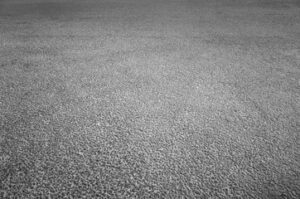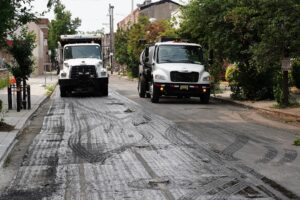Pavement is designed to transfer wheel load stresses from vehicles to the subgrade. Most of the geotechnical factors that affect pavement performance relate to stiffness and strength.

The sub-grade is the underlying ground upon which all other pavement layers will be constructed. It is the most important of all the pavement construction layers, as it is responsible for transmitting vehicular load stresses to the base course and the surface layer(s). The sub-grade should be made of a material capable of supporting the loads without causing deformation or settlement problems. This material may also need to be stabilized in order to provide a suitable foundation for the rest of the paving construction.
A capping layer is usually placed on the sub-grade if the soil is structurally weak or is expected to be subjected to exceptional loads. The capping layer is typically a selected fill material, generally a crushed rock, placed in layers no greater than 225mm thick and thoroughly compacted before placing the next layer. The engineer will determine the thickness required to adequately support the anticipated traffic loading.
Generally, the sub-grade should not contain silt or clay and be free of organic materials as these will decompose under the heavy construction loads. Sub-grade should be properly graded to ensure a smooth, level and even surface.
If the sub-grade soil has insufficient strength for the proposed traffic loads it can be improved by blending in lime or Portland cement or by treating with asphaltic binder and thorough compaction. In addition, the soil can be stabilized by incorporating a geosynthetic or other material. These products are designed to prevent moisture intrusion or expulsion and reduce swelling tendencies.
A simple way to check the moisture content bearing capacity of a soil is to squeeze it in your hand; if it stays together and has powdery texture then it is too dry and needs to be moistened, while a ball that breaks apart readily indicates that the sub-grade soil is at its optimum moisture content.
There are various laboratory tests that can be used to evaluate the strength of a sub-grade; these include the CBR test, falling weight deflectometer, and indirect shear testing. However, these are costly and labor intensive and are only able to evaluate a small sample area. For this reason, most engineers use their engineering judgment to establish limits and quantities of sub-grade stabilization based on subsurface exploration results and proof rolling evaluations.
Base Course
The base course is a layer of specified or selected material of designed thickness placed on the subgrade (or on the unbound granular base if a subbase is not used) to provide a uniform and stable support for the binder and surface courses. It typically provides a significant portion of the structural capacity in flexible pavement systems and improves foundation stiffness in rigid pavements. It also minimizes intrusion of fines from the subgrade into the pavement structure and improves drainage.
A high quality granular or crushed rock aggregate is generally used to form the base. The aggregates may be used as-is or treated with various stabilizing admixtures to increase the strength and stiffness of the base material and/or to help reduce the total pavement thickness for cost savings. For example, the base may be treated with Portland cement, asphalt emulsions, lime or flyash to increase its strength, density and/or porosity.
Whether or not the base is bound with bitumen, it must be densely compacted to achieve proper load distribution and improve drainage characteristics of the pavement. In the case of a bituminous pavement, the base may be made from either hot-paved or cold-paved asphalt (HMA). Increasingly, a percentage of recycled construction materials are being used in the production of these mixes.
In the case of a non-bituminous pavement, a mineral aggregate mixture is used for the base. This mixture can be bound with bitumen if it is heated or it can be hydraulically bound if bitumen is not used and the aggregates are mixed with cement or lime.
For cold-paved bituminous pavements, the base is usually made from a hot or cold mix of aggregate and a liquid asphalt binding agent. Typically the bituminous base mixes are comprised of aggregates from uncrushed gravel and coarse aggregate to crushed granite, recycled concrete, and/or crushed sand.
In some instances, a frost blanket is included in the base layer to insulate the base and subgrade layers from moisture action that can lead to frost damage within the pavement structure. Frost damage occurs as water within the pavement structure freezes and expands, exerting tensile stresses in the layers below it. These stresses must be relieved to avoid failure of the pavement structure.
Binder Course
A binder course is the layer that binds together aggregate and hot-mix asphalt. It is a load-bearing layer and must be strong enough to support the traffic loads for as long as several decades. The material used for the binder course varies depending on the specific use. In general, it is a mix of coarse and fine aggregates with a bituminous binder. Aggregates used for this purpose could be crushed rock, sand, gravel and/or recycled materials such as concrete, slag or reclaimed asphalt pavement (RAP). The binder is typically bitumen but in recent times other bio-based binders are also being tested.
The quality of the binder is crucial for the performance of the asphalt pavement. For this reason, shear and rut resistance testing of the asphalt binder is performed in advance of construction. This test is known as grading of asphalt binders and the results are used to establish a Performance-Graded (PG) asphalt binder specification. The shear and rut resistance tests are conducted using a rotational viscometer, COC flashpoint tester and dynamic shear and bending beam rheometers.
In addition, the PG grading system includes physical performance tests such as penetration, softening point and ductility. In order to obtain accurate shear and rut resistance results, the asphalt binder must be subjected to careful temperature control. This is because for various reasons, asphalt binders tend to harden with time.
For these reasons, this class provides the latest information about testing and grading of asphalt binders. It offers extensive hands-on lab experience that enables students to perform all required tests and make the necessary calculations. A review exam is also provided near the end of the class. This class is recommended for anyone who is responsible for asphalt testing, materials approval and specification. It is also ideal for asphalt paving contractors and engineers who want to understand the current practices in asphalt testing, grading and quality control. The course is offered in an onsite format or as an online class.
Surface Course
The top layer of the pavement structure that comes in direct contact with traffic loads, the surface course is the most critical element for a pavement to function properly. It needs to be hardy enough to resist skidding, traffic abrasion and the disintegrating effects of climate. It also needs to be tough enough to prevent distortion and prevent water from penetrating into the underlying layers.
The asphalt surface layer may be constructed in several different ways including traditional hot rolled asphalt (HMA), soft asphalt, porous asphalt or NatraTex. These materials are used in the construction of a range of infrastructure projects including footpaths, cycle paths, residential and commercial driveways and main roads.
Depending on the design of the pavement the subbase layer may be an unbound granular layer or a road asphalt base course. The function of the base course is to spread the load from the asphalt surface layer over a greater area thus reducing the overall stress on the subgrade soils and the asphalt binder layer. It also serves to minimize the intrusion of fines from the subgrade into the pavement structure and improve drainage.
The subgrade soils are under a constant amount of stress from the traffic and environmental loads, which transfer through the pavement layers. It is essential that the subgrade be well compacted to a high density and within its optimum moisture content to prevent over-stressing of the material.
Once the base and subbase courses are placed on the roadway, it is time for the paving contractor to construct the final surface course. The surfacing material of choice for most highways and major roads is HMA, sometimes known as bituminous macadam or blacktop. However, there are a wide range of alternative materials that can be used in the construction of a road or parking lot including chip seal and self-binding gravel.
The surface course is important for the durability of a pavement, and is typically constructed with aggregates that have a size distribution that will create a smooth, durable, waterproof riding surface with good skid resistance. In addition to its surface properties, the surface course is important for a pavement because it provides a strong connection between the roadbed and the traffic surface. It is also a key component in the identification of distress in a pavement, so that it can be corrected before it progresses to the underlying intermediate or binder layer.
